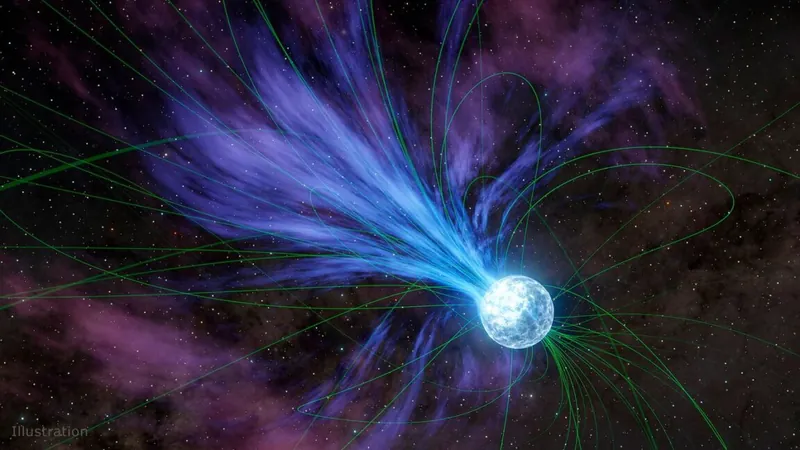
New Discoveries Suggest Fast Radio Bursts Emanate from Stellar Surfaces
2025-01-03
Author: Lok
Introduction
When fast radio bursts (FRBs) first struck the astronomical community in 2007, they left scientists baffled. These mysterious celestial events emit brief but powerful radio waves, often followed by long stretches of silence. While some sources are known to generate repeated bursts, the majority remain sporadic and elusive. Over the years, extensive data collection has led researchers to narrow their focus on magnetars, highly magnetized neutron stars, as potential origins of FRBs. However, questions linger: Is a magnetar essential for producing FRBs, or could less magnetically active neutron stars also trigger these phenomena? Additionally, the precise mechanisms behind the bursts still elude scientists. The bursts may be the result of events occurring within a star's magnetic field, or they could involve the star ejecting energetic material that leads to FRB creation further away.
A Groundbreaking Observation
Recent observations have provided groundbreaking insights into the nature of FRBs. In October 2022, scientists detected a noteworthy burst designated FRB 20221022A using the Canadian Hydrogen Intensity Mapping Experiment (CHIME). Not only is CHIME adept at monitoring a vast area of the sky, but this incident marked a significant localized event associated with a nearby galaxy situated approximately 200 million light-years from Earth. The proximity of this galaxy was vital for two reasons: it ensured that the radio waves arriving on our planet were powerful enough for comprehensive analysis, and it meant that the waves had minimal interaction with the intergalactic medium, thus preserving data about the material within the local galaxy and our own Milky Way.
Quick-Paced Polarization Changes
Research stemming from this unique FRB reveals remarkable characteristics, particularly involving the polarization of light emitted from the burst. One study highlighted a rapid change in the angle of polarization across the 2.5 milliseconds that FRB 20221022A lasted. A striking S-shaped pattern was observed, indicative of behavior seen in about half of known pulsars—rapidly spinning neutron stars that emit beams of radiation. This exciting finding points towards the likelihood that the source of this FRB resides on a compact and fast-rotating celestial object. While FRB 20221022A is currently the only one known to exhibit such behavior, its similarities with pulsars suggest that more discoveries could be on the horizon.
Insights into Intergalactic Interactions
Another study delved deeper into the effects of the interstellar medium on FRB 20221022A. During their analysis, researchers noticed fluctuation patterns known as scintillation—a phenomenon comparable to how stars twinkle due to atmospheric disturbances. The bursts must have interacted with material in both the source galaxy and our Milky Way, causing two main sources of scintillation to be detected. Investigating the potential scattering effects, the researchers concluded that the FRB likely emanated from close to the source object, with scattering occurring mainly from materials inside the galaxy, effectively ruling out the hypothesis that material was ejected far from the source before interacting.
A New Era of Understanding?
Despite these thrilling discoveries, the astronomical community must remain cautious. The findings from FRB 20221022A may not necessarily apply to all FRBs, particularly those from previously identified repeating sources. The possibility exists that multiple processes could generate FRBs, leading to a complex and layered understanding of these phenomena. As research continues and as we analyze more FRBs, however, trends and commonalities are expected to emerge, slowly clarifying the enigmatic nature of these stellar events. The sky might hold even more secrets about the origins of fast radio bursts than we can currently fathom! Stay tuned as scientists strive to unravel these cosmic mysteries, potentially reshaping our comprehension of the universe.


 Brasil (PT)
Brasil (PT)
 Canada (EN)
Canada (EN)
 Chile (ES)
Chile (ES)
 Česko (CS)
Česko (CS)
 대한민국 (KO)
대한민국 (KO)
 España (ES)
España (ES)
 France (FR)
France (FR)
 Hong Kong (EN)
Hong Kong (EN)
 Italia (IT)
Italia (IT)
 日本 (JA)
日本 (JA)
 Magyarország (HU)
Magyarország (HU)
 Norge (NO)
Norge (NO)
 Polska (PL)
Polska (PL)
 Schweiz (DE)
Schweiz (DE)
 Singapore (EN)
Singapore (EN)
 Sverige (SV)
Sverige (SV)
 Suomi (FI)
Suomi (FI)
 Türkiye (TR)
Türkiye (TR)
 الإمارات العربية المتحدة (AR)
الإمارات العربية المتحدة (AR)